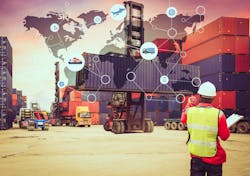Technology and Nearshoring Are Transforming Transportation
A number of significant pressures are coming to bear on the transportation networks.
A new report by Deloitte, The Future of Freight: Transforming the Movement of Goods, identifies a number of trends affecting the industry. One of the most visible is the fact that many companies are nearshoring to both shorten and bolter their supply chains. The global landscape is changing as well with China’s dominance decreasing, with expectations of its trade growth to drop from 26% to 13% in the next five years.
Elsewhere in the world, countries in Central and Southeastern Europe, as well as Central America and Mexico, picking up the slack with competitive labor and closer proximity to end-use markets.
At the same time, trade patterns are shifting and technology is advancing quickly, particularly in data science (artificial intelligence and data analytics), material science (electric vehicles), and engineering (autonomous vehicles). “Every shift represents an opportunity for new competitors to enter the market, as startups, megaretailers, and hyperscalers all vie for a piece of the trillions of dollars at stake,” the report says.
To help industry navigate the future the report offers these key conclusions:
Onshoring and nearshoring are redrawing the transportation map. Transportation executives preparing for nearshoring anticipate 20% of Asia-originating freight will move to closer-proximity markets by 2025, doubling to 40% of freight originations by 2030. This will create new opportunities as companies look to bring operations closer to the end consumer to mitigate disruption risk and the inflationary impact on the cost of goods.
Data is a differentiator. Over the next three years, surveyed companies expect data will offer better visibility into assets and goods (48%), improved customer relationship management (44%) and more efficient workforce optimization (35%), underscoring the role data and analytics will play as companies seek new opportunities.
Expect a rise in new competitive dynamics. As the industry reconstitutes itself, cloud services providers, mega-retailers, vehicle manufacturers, and tech startups are pursuing the transportation industry and its profit streams. In fact, nearly 60% expect these new providers to emerge as leaders in the shifting environment, positioned to usurp territory and customers from legacy logistics companies while prompting new models of collaboration.
Next-gen vehicles will drive competition. 60% believe it is inevitable that truck manufacturers will seek to become fleet managers as technology advances and lines of supply are redrawn, foreshadowing a potential power shakeup as more companies look to leverage next-gen transportation tech.
Core capabilities with align with shifting demands. Transportation leaders recognize the need to adjust capabilities to meet demand and are looking ahead to opportunities to restructure their operations. 60% are outsourcing non-core capabilities and 59% are actively seeking acquisitions to expand their capabilities.
